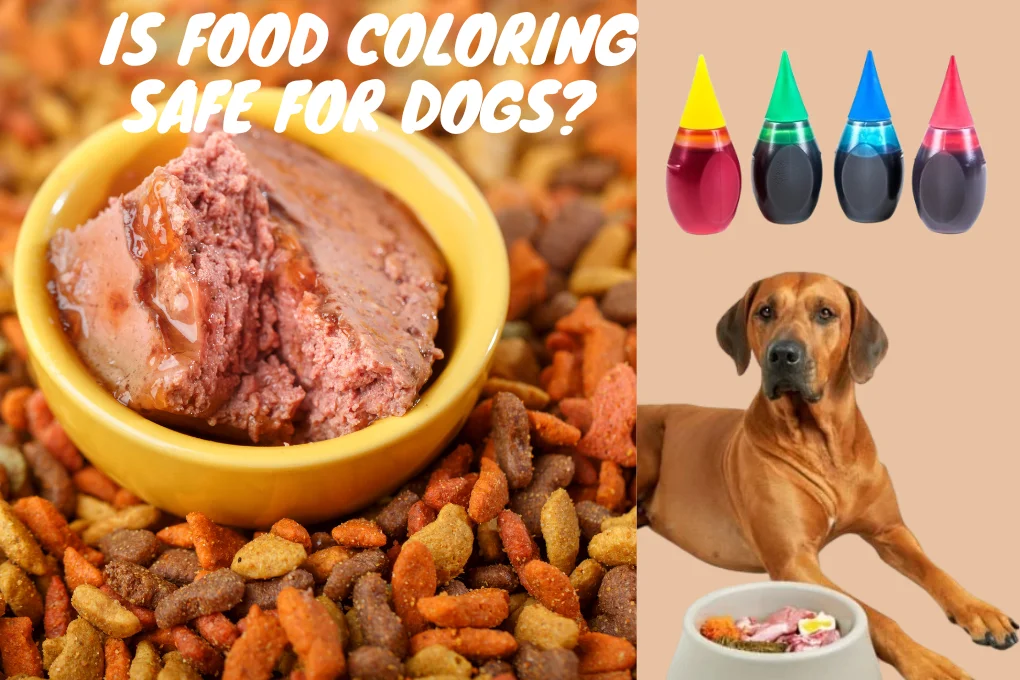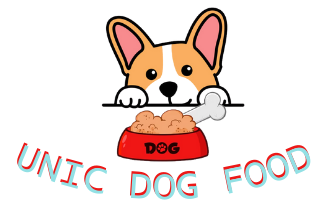Today, I want to delve into a topic that often sparks curiosity among dog owners: “Is food coloring safe for dogs?”
In recent years, as pet owners have become increasingly conscious about the ingredients in their furry friends’ diet, questions about the safety of food coloring for dogs have gained prominence.
As a pet expert, I’ve delved into the details to help you navigate this colorful concern.
Join me as I unravel the colorful world of pet nutrition and share my insights on whether adding a splash of vibrancy to your pup’s treats is a safe bet.
Let’s get straight to the scoop on this intriguing question on many dog lovers’ minds.
What’s in Food Coloring?
Food coloring comprises various synthetic or natural compounds, including chemicals like dyes and pigments. These substances are added to enhance or change the color of food and drinks.
Initially crafted from coal tar, artificial food colorings have evolved, with modern synthetic food dyes now derived from petroleum or crude oil.
Rigorous testing is conducted to guarantee the absence of any petroleum traces in the final products.
Synthetic colors are commonly used in processed foods, while natural sources like fruits and vegetables contribute to some food colorings.
It’s essential to be aware of the specific ingredients in food coloring products to make informed choices, especially when considering their impact on health.
Understanding Food Coloring
Food coloring comes in various types, with artificial variants commonly used in commercial pet products.
These additives serve aesthetic purposes, making pet food visually appealing. Recognizing the types of food coloring agents and their sources is crucial to making informed choices.

Ingredients to Avoid
Not all food coloring is created equal. Some ingredients, such as Red 40 and Yellow 5, have been associated with adverse effects in dogs.
These may include allergies, hyperactivity, or digestive issues. Pet owners must familiarize themselves with harmful ingredients to protect their canine companions.
Is Food Coloring Safe For Dogs?
While small amounts may be safe, excessive intake can pose risks. Always check product labels. Opt for natural alternatives found in fruits and veggies, like carrots or blueberries.
Food dye lacks nutritional value, contributing no extra calories, vitamins, or minerals. Its primary function is to enhance the visual appeal of products for pet parents.
Despite being calorie-free, it’s crucial to recognize that food dye isn’t without potential risks. Pet parents should consider these risks when considering dog food and treats containing coloring agents before purchasing.
Where does food coloring in dog food come from?
I source information about the origin of food coloring in dog food from various studies and experts. Typically, these colors come from synthetic or natural compounds.
Manufacturers often use artificial dyes in commercial pet foods to achieve specific shades. Additionally, natural sources like turmeric or beet pulp are used for a more healthful approach.
It may surprise you that artificial food coloring is made from petroleum—the same substance used to make fuel!
While many artificial food coloring ingredients have been outlawed over time, some artificial dyes are still permitted and are frequently used in dog treats and food.
We must remain knowledgeable about these ingredients for our furry friends’ well-being.
Why do pet food companies use food coloring in dog foods?
Pet food companies use food coloring in dog foods for various reasons. Primarily, it’s done to make the food visually appealing to pet owners.
Colorful kibbles or treats are often more attractive and appealing to consumers. Additionally, food coloring helps maintain a consistent and recognizable appearance for a brand’s products.
While the aesthetic aspect is aimed at pleasing pet owners, consumers need to be aware of the types of food coloring used and their potential impact on the health of their dogs.
Here are the 5 best reasons why pet food companies use food coloring in dog foods.
Enhances Visual Appeal
Adding food coloring to dog foods is a simple yet effective way to catch the eye of pet owners. The vibrant hues of kibbles or treats make the meal look more appealing and appetizing.
As a pet enthusiast, I’ve noticed that a visually enticing bowl of food can create a positive association for both pet and owner, enhancing the overall feeding experience.
Brand Recognition
Consistency in appearance is key for pet food brands. By using food coloring, companies can create a distinct visual identity for their products.
As a result, when I stroll through the pet food aisle, I can easily spot my preferred brand by its consistent and recognizable coloring, instilling a sense of trust in the quality and familiarity of the product.
Consumer Preferences
Just like us, pet owners are drawn to aesthetically pleasing items. Colorful dog food often aligns with the perception of freshness and quality.
The market responds to consumer preferences, and as someone who deeply cares for my furry friend, I appreciate when pet food companies take the extra step to provide visually appealing options that align with my tastes.
Market Competitiveness
In the bustling world of pet products, standing out is crucial. Food coloring becomes a tool for brands to gain a competitive edge.
As a consumer, I am more likely to explore and consider a product that visually distinguishes itself on the shelf.
It’s a simple yet effective strategy for companies to remain competitive in the ever-growing pet food market.
Marketing Strategy
Beyond the product, the visual aspect plays a significant role in marketing. Brightly colored kibbles or treats attract pet owners’ attention and contribute to visually appealing marketing materials.
As a pet parent, these visuals create a positive association with the product, influencing my purchasing decisions and contributing to an overall positive experience for both me and my furry companion.
Is food coloring safe for dogs if it’s been FDA-approved?
Yes, if a food coloring is FDA-approved, it’s generally considered safe for dogs. The FDA ensures rigorous testing and scrutiny before approval.
However, individual sensitivities can vary, so monitoring your pup for any adverse reactions is wise.
Always check the specific type of coloring used, as some dogs may be sensitive to certain additives.
As a cautious pet parent, consulting with your vet about your dog’s dietary needs and potential sensitivities is a proactive step to ensure your furry friend’s well-being.
Can dogs eat food coloring? What are the risks if they do?
Dogs can consume food coloring in moderation without significant risks. However, excessive intake may lead to potential health issues.
Risks include gastrointestinal upset, allergic reactions, or, in rare cases, toxicity. Certain artificial dyes may have adverse effects on sensitive individuals.
Always check the specific type of coloring used and consult with a vet if unsure.
After introducing foods containing coloring, it’s critical to watch for any odd behavior, stomach problems, or allergic reactions in your dog.
Moderation and awareness are essential to ensure your dog’s overall wellbeing, as with any dietary change.
Should You Add Food Coloring to Homemade Dog Food and Treats?
As a pet food expert, I recommend caution when adding coloring to homemade dog food and treats.
While it might make the treats visually appealing, it doesn’t hold the same significance for our canine companions.
Firstly, dogs aren’t as visually driven as humans, so the aesthetics don’t impact their enjoyment.
Moreover, some dogs may be sensitive to certain dyes, leading to digestive issues or allergies.
If you add color, opt for natural alternatives like beet juice or turmeric, ensuring safety.
Always prioritize your pup’s health over appearance and consult your vet to make informed decisions about your homemade dog treats.
Can dogs digest food coloring?
Yes, dogs can generally digest food coloring. However, the ability to digest depends on the type and amount of coloring used.
While most commercial pet foods use safe colorings, excessive or certain artificial dyes might cause digestive upset or allergic reactions in some dogs.
Be mindful of the specific coloring agents and monitor your dog for any adverse reactions. When in doubt, consult with your veterinarian to ensure the safety of the food additives in your dog’s diet.
FAQs
Is all food coloring harmful to dogs?
Not all food coloring is harmful. Natural alternatives like beet juice and turmeric are safe and offer nutritional benefits.
What should I look for when reading pet food labels?
Check for artificial coloring agents like Red 40 and Yellow 5. Look for products complying with regulatory standards.
Can I trust homemade treats with food coloring?
Yes, if using safe alternatives like natural fruits and vegetables. Homemade treats offer full control over your dog’s diet.
Conclusion
Careful thought must be given to food coloring safety for dogs. Pet owners can enhance their dog’s overall health through knowledge of coloring types, identification of potentially harmful ingredients, and informed decision-making.
A responsible pet parent keeps abreast of market developments, seeks expert advice, and actively participates in decision-making.
- Homemade Bone Broth For Dog Recipe - December 17, 2025
- Can You Cook Raw Dog Food? - September 10, 2025
- Homemade No-Bake Dog Treat Recipes Your Pup Will Love - September 6, 2025
